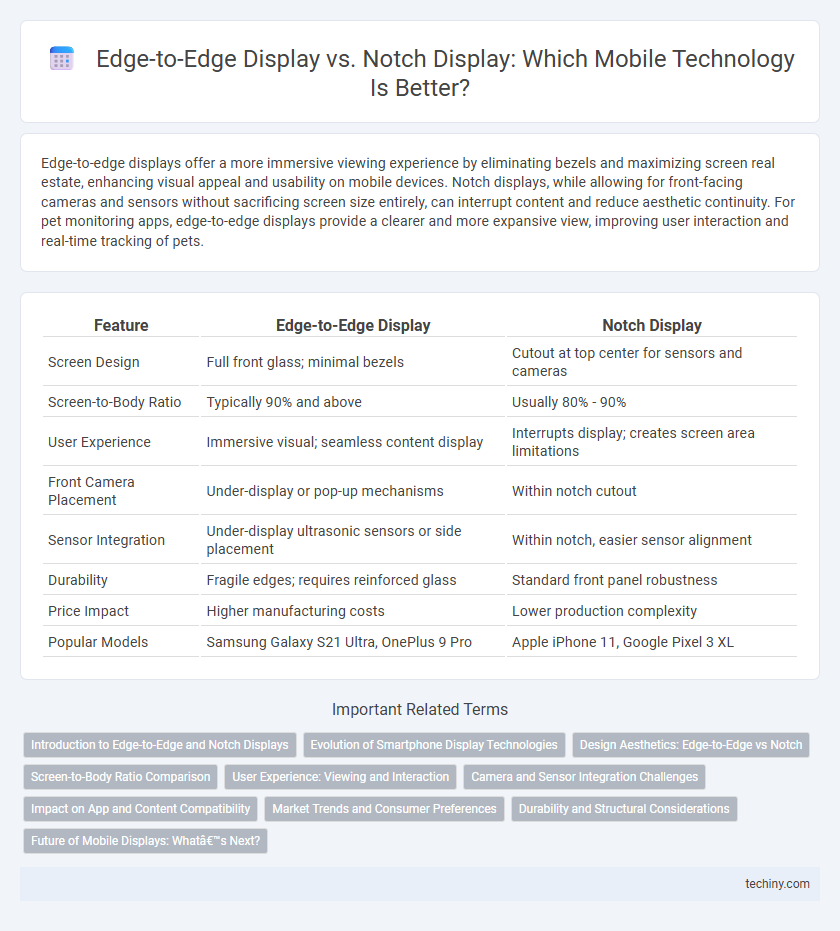Edge-to-edge displays offer a more immersive viewing experience by eliminating bezels and maximizing screen real estate, enhancing visual appeal and usability on mobile devices. Notch displays, while allowing for front-facing cameras and sensors without sacrificing screen size entirely, can interrupt content and reduce aesthetic continuity. For pet monitoring apps, edge-to-edge displays provide a clearer and more expansive view, improving user interaction and real-time tracking of pets.
Table of Comparison
| Feature | Edge-to-Edge Display | Notch Display |
|---|---|---|
| Screen Design | Full front glass; minimal bezels | Cutout at top center for sensors and cameras |
| Screen-to-Body Ratio | Typically 90% and above | Usually 80% - 90% |
| User Experience | Immersive visual; seamless content display | Interrupts display; creates screen area limitations |
| Front Camera Placement | Under-display or pop-up mechanisms | Within notch cutout |
| Sensor Integration | Under-display ultrasonic sensors or side placement | Within notch, easier sensor alignment |
| Durability | Fragile edges; requires reinforced glass | Standard front panel robustness |
| Price Impact | Higher manufacturing costs | Lower production complexity |
| Popular Models | Samsung Galaxy S21 Ultra, OnePlus 9 Pro | Apple iPhone 11, Google Pixel 3 XL |
Introduction to Edge-to-Edge and Notch Displays
Edge-to-edge displays maximize screen real estate by extending the display panel across the entire front surface of mobile devices, eliminating borders and providing an immersive viewing experience. Notch displays feature a cutout at the top of the screen to accommodate front-facing cameras and sensors, balancing screen space with essential hardware integration. The evolution from notch to edge-to-edge technology highlights advancements in display manufacturing and sensor miniaturization.
Evolution of Smartphone Display Technologies
Edge-to-edge displays represent a significant advancement in smartphone technology by maximizing screen real estate and providing an immersive visual experience compared to traditional notch displays, which interrupt the screen with cutouts for cameras and sensors. The evolution from notch to edge-to-edge displays reflects improvements in OLED and under-display camera technologies, enabling manufacturers like Samsung and Apple to reduce bezels and enhance screen-to-body ratios. This shift promotes more seamless interactions and better content visibility, driving the future standard for mobile device interfaces.
Design Aesthetics: Edge-to-Edge vs Notch
Edge-to-edge displays offer a sleek, immersive visual experience by maximizing screen real estate and minimizing bezels, which enhances modern smartphone aesthetics. Notch displays interrupt the screen with cutouts for cameras and sensors, creating a less seamless design but enabling functional hardware placement. Consumer preference increasingly favors edge-to-edge designs due to their futuristic appearance and uninterrupted content viewing.
Screen-to-Body Ratio Comparison
Edge-to-edge displays maximize screen-to-body ratio by extending the display panel seamlessly to the device edges, achieving ratios often above 90%. In contrast, notch displays reduce the usable screen area by incorporating a cutout for sensors and cameras, typically resulting in screen-to-body ratios around 80-85%. Higher screen-to-body ratios in edge-to-edge designs enhance immersive viewing experiences and modern device aesthetics.
User Experience: Viewing and Interaction
Edge-to-edge displays maximize screen real estate, offering immersive viewing experiences by minimizing distractions and allowing users to engage with content seamlessly. Notch displays, while sometimes reducing display area, accommodate essential sensors without compromising overall device functionality but can interrupt full-screen visuals and gestures. Enhanced touch responsiveness and uninterrupted screen flow on edge-to-edge panels significantly improve interaction efficiency and user satisfaction.
Camera and Sensor Integration Challenges
Edge-to-edge displays maximize screen real estate but pose significant challenges for camera and sensor integration, requiring under-display camera technology or innovative sensor placement to avoid compromising visual quality. Notch displays, while less immersive, provide dedicated space for front-facing cameras and sensors, simplifying integration and maintaining optimal performance. Balancing aesthetic appeal and functional sensor performance is crucial in mobile device design, driving advancements in miniaturization and optical engineering.
Impact on App and Content Compatibility
Edge-to-edge displays enhance immersive user experiences by maximizing screen real estate, but they pose challenges for app developers who must optimize content to avoid obstructions from curved edges and rounded corners. Notch displays, featuring a cutout for sensors, require adaptive UI designs to prevent key content from being hidden, impacting app layout and usability. Ensuring app and content compatibility across both display types necessitates responsive design frameworks and dynamic scaling techniques to maintain functionality and visual integrity.
Market Trends and Consumer Preferences
Edge-to-edge displays are becoming the dominant trend in mobile technology, with market data showing a 35% year-over-year increase in devices featuring this design, driven by consumer demand for immersive viewing experiences. In contrast, notch displays are declining in popularity as users prioritize screen real estate and sleek aesthetics, reflected by a 20% decrease in new smartphone models incorporating notches in the past year. Consumer preference surveys indicate 78% favor edge-to-edge screens for media consumption and gaming, influencing manufacturers to adopt bezel-less designs to enhance user engagement and device appeal.
Durability and Structural Considerations
Edge-to-edge displays offer a sleek, immersive visual experience but often require reinforced materials like Gorilla Glass and metal frames to maintain durability under stress. Notch displays incorporate additional structural support around the notch area, which can improve overall device integrity by distributing pressure more evenly. Manufacturers balance these design choices by optimizing internal chassis reinforcements to prevent screen damage and maintain structural rigidity across usage conditions.
Future of Mobile Displays: What’s Next?
Edge-to-edge displays offer an immersive viewing experience by maximizing screen real estate and eliminating bezels, setting a new standard for mobile device aesthetics and usability. Notch displays, once popular for housing front cameras and sensors, are giving way to innovative solutions like under-display cameras and hole-punch designs that preserve screen integrity while enhancing functionality. The future of mobile displays focuses on seamless integration of hardware and software, with advancements in flexible AMOLED panels and improved biometric sensors driving next-generation user interfaces.
Edge-to-Edge Display vs Notch Display Infographic

 techiny.com
techiny.com